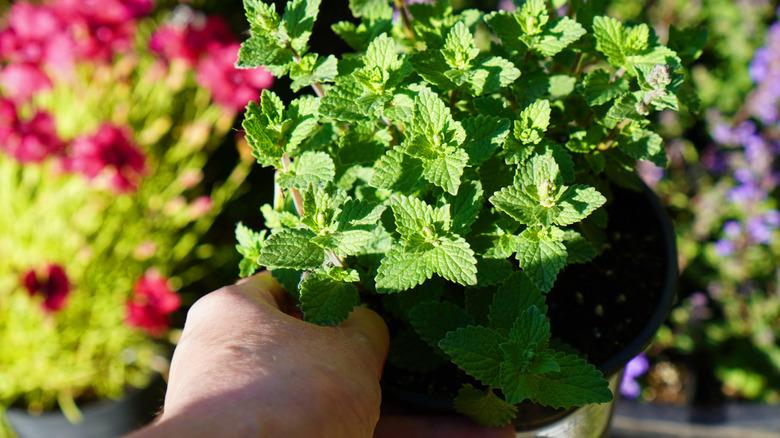The Popular Plant That Can Help Keep Roaches Away From Your Home And Garden
Cockroaches are famously hardy creatures, and it can therefore be daunting trying to figure out how to get rid of roaches when they've been spotted in your home and garden. However, one study has found that these creatures' evolutionary strengths can actually be used against them with a single household addition. And it's one your cats will thank you for, too.
As reported in American Chemical Society, researchers from Iowa State University presented findings that gave credit to the long-held belief that catnip, a scent which is enticing to felines, is also a strong repellent for cockroaches. Their analysis shows that a chemical found in the plant called nepetalactone is repulsive to these crawling insects and could act as a natural repellant, offering an attractive natural alternative to harsh insecticides. And, while the study was only performed on one type of species — the German cockroach — researcher Chris Peterson expressed optimism that catnip could also be an effective deterrent against the nocturnal American roaches as well. So, why might it work?
Why might catnip repel roaches?
One reason roaches may be repulsed by catnip is their extremely refined sense of smell. Over centuries, cockroaches have evolved to have hyper-sensitive antennae equipped with olfactory receptors which allow them to forage for food in a variety of environments. This means that when they come into contact with a particularly strong smell, they may be physically repelled and even pained by it.
This theory is supported by anecdotal reports which suggest that other strong-smelling plants and essential oils have also been effective at warding off cockroaches in the past. For example, Eco Guard Pest Management recommend plants such as rosemary, chrysanthemum, and mint as chemical-free ways to keep roaches out of your home, as well as essential oils like peppermint, lavender, and tea tree. Helpfully, many of these ingredients can also be used to make homemade bug sprays to ward off other insects such as mosquitos, flies, and ants.
How to use catnip to ward off cockroaches
Catnip can be planted, or its leaves can be spread, in any areas where cockroaches have been previously spotted. However, veterinarians such as Small Door Vet advise that cats ingesting too much of the herb can suffer from digestive discomfort or even vomiting and diarrhea. If you do have feline friends at home, it is a good idea to check ahead of time which indoor plants are safe for cats before introducing any new ones into your space. Alternatively, catnip can also be boiled, left to cool, and then poured into a spray bottle as a liquid repellent. This can then be misted around the house where the insects tend to appear, reducing the amount your pets can consume.
However, when considering catnip as a cockroach solution, it is important to note that this and other herbs work solely as a preventative measure at times when only one or two of the insects have been spotted in or around your home. If more have been seen, check to make sure that no food has been left out, which may be actively attracting them. And, if you are concerned about a full-fledged roach infestation in your home, it is best to consult a pest control specialist about crucial next steps.


